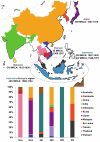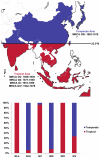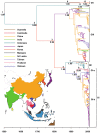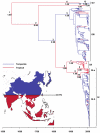Phylogeography of Japanese encephalitis virus: genotype is associated with climate - PubMed (original) (raw)
Phylogeography of Japanese encephalitis virus: genotype is associated with climate
Amy J Schuh et al. PLoS Negl Trop Dis. 2013.
Abstract
The circulation of vector-borne zoonotic viruses is largely determined by the overlap in the geographical distributions of virus-competent vectors and reservoir hosts. What is less clear are the factors influencing the distribution of virus-specific lineages. Japanese encephalitis virus (JEV) is the most important etiologic agent of epidemic encephalitis worldwide, and is primarily maintained between vertebrate reservoir hosts (avian and swine) and culicine mosquitoes. There are five genotypes of JEV: GI-V. In recent years, GI has displaced GIII as the dominant JEV genotype and GV has re-emerged after almost 60 years of undetected virus circulation. JEV is found throughout most of Asia, extending from maritime Siberia in the north to Australia in the south, and as far as Pakistan to the west and Saipan to the east. Transmission of JEV in temperate zones is epidemic with the majority of cases occurring in summer months, while transmission in tropical zones is endemic and occurs year-round at lower rates. To test the hypothesis that viruses circulating in these two geographical zones are genetically distinct, we applied Bayesian phylogeographic, categorical data analysis and phylogeny-trait association test techniques to the largest JEV dataset compiled to date, representing the envelope (E) gene of 487 isolates collected from 12 countries over 75 years. We demonstrated that GIII and the recently emerged GI-b are temperate genotypes likely maintained year-round in northern latitudes, while GI-a and GII are tropical genotypes likely maintained primarily through mosquito-avian and mosquito-swine transmission cycles. This study represents a new paradigm directly linking viral molecular evolution and climate.
Conflict of interest statement
The authors have declared that no competing interests exist.
Figures
Figure 1. Geographical distribution of the JEV sequences included in this study according to country of collection.
The coloring of the chart corresponds to the map and shows the relative proportions of viral sequences sampled from each country according to genotype. Of note, GI viruses have also been isolated in India, Laos and Malaysia, GII viruses have also been isolated in Papua New Guinea and Thailand, and GIII viruses have also been isolated in Malaysia, Myanmar, Nepal, the Philippines, the former Soviet Union and Thailand. These viruses were not included in this study, as the E gene of these viruses has not been sequenced. The estimated dates (95% HPD interval) and locations for the MRCA of JEV, as well as its five genotypes are also shown.
Figure 2. Geographical distribution of the JEV sequences included in this study according to climate of collection.
The coloring of the chart corresponds to the map and shows the relative proportions of viral sequences sampled from each climate according to genotype. The estimated dates (95% HPD interval) and location for the MRCA of JEV, as well as its five genotypes are also shown.
Figure 3. Country Bayesian MCC phylogeny of the JEV sequences.
GI-V are represented to the right of the tree. Branch tips correspond to the date of collection of each of the virus isolates from which JEV sequence information was derived. Branch lengths correspond to lengths of time (in years), as measured by the scale underneath the tree. Terminal branches are colored according to the sampling location of the taxon at the tip, while internal braches are colored according to the most probable location of their child node. The branch colors correspond to those used in the map and legend. The numbers to the upper-left of the nodes correspond to the country phylogeographic analysis date presented in Table 2 and the numbers to the lower-left of the nodes are posterior probability values.
Figure 4. Climate Bayesian MCC phylogeny of the JEV sequences.
GI-V are represented to the right of the tree. Branch tips correspond to the date of collection of each of the virus isolates from which JEV sequence information was derived. Branch lengths correspond to lengths of time (in years), as measured by the scale underneath the tree. Terminal branches are colored according to the sampling location of the taxon at the tip, while internal braches are colored according to the most probable location of their child node. The branch colors correspond to those used in the map and legend. The numbers to the upper-left of the nodes correspond to the country phylogeographic analysis date presented in Table 3 and the numbers to the lower-left of the nodes are posterior probability values.
Similar articles
- Dynamics of the emergence and establishment of a newly dominant genotype of Japanese encephalitis virus throughout Asia.
Schuh AJ, Ward MJ, Leigh Brown AJ, Barrett AD. Schuh AJ, et al. J Virol. 2014 Apr;88(8):4522-32. doi: 10.1128/JVI.02686-13. Epub 2014 Feb 5. J Virol. 2014. PMID: 24501419 Free PMC article. - Genetic diversity of Japanese encephalitis virus isolates obtained from the Indonesian archipelago between 1974 and 1987.
Schuh AJ, Guzman H, Tesh RB, Barrett AD. Schuh AJ, et al. Vector Borne Zoonotic Dis. 2013 Jul;13(7):479-88. doi: 10.1089/vbz.2011.0870. Epub 2013 Apr 16. Vector Borne Zoonotic Dis. 2013. PMID: 23590316 Free PMC article. - Molecular epidemiology of Japanese encephalitis in northern Vietnam, 1964-2011: genotype replacement.
Do LP, Bui TM, Hasebe F, Morita K, Phan NT. Do LP, et al. Virol J. 2015 Apr 1;12:51. doi: 10.1186/s12985-015-0278-4. Virol J. 2015. PMID: 25889499 Free PMC article. - Review of climate, landscape, and viral genetics as drivers of the Japanese encephalitis virus ecology.
Le Flohic G, Porphyre V, Barbazan P, Gonzalez JP. Le Flohic G, et al. PLoS Negl Trop Dis. 2013 Sep 12;7(9):e2208. doi: 10.1371/journal.pntd.0002208. eCollection 2013. PLoS Negl Trop Dis. 2013. PMID: 24069463 Free PMC article. Review. - Potential Role of Birds in Japanese Encephalitis Virus Zoonotic Transmission and Genotype Shift.
Hameed M, Wahaab A, Nawaz M, Khan S, Nazir J, Liu K, Wei J, Ma Z. Hameed M, et al. Viruses. 2021 Feb 24;13(3):357. doi: 10.3390/v13030357. Viruses. 2021. PMID: 33668224 Free PMC article. Review.
Cited by
- Isolation and Genetic Characterization of Japanese Encephalitis Virus Two Decades after Its Elimination in Singapore.
Lim MJ, Loh ZY, Yeo HL, Yenamandra SP, Kong M, Pang HY, Lee MH, Humaidi M, Chua C, Griffiths J, Ng LC, Hapuarachchi HC, Mailepessov D. Lim MJ, et al. Viruses. 2022 Nov 28;14(12):2662. doi: 10.3390/v14122662. Viruses. 2022. PMID: 36560666 Free PMC article. - The Ecology and Evolution of Japanese Encephalitis Virus.
Mulvey P, Duong V, Boyer S, Burgess G, Williams DT, Dussart P, Horwood PF. Mulvey P, et al. Pathogens. 2021 Nov 24;10(12):1534. doi: 10.3390/pathogens10121534. Pathogens. 2021. PMID: 34959489 Free PMC article. Review. - Japanese B Encephalitis.
Mehta A, Singh R, Mani VE, Poddar B. Mehta A, et al. Indian J Crit Care Med. 2021 May;25(Suppl 2):S171-S174. doi: 10.5005/jp-journals-10071-23843. Indian J Crit Care Med. 2021. PMID: 34345134 Free PMC article. - Differential Infectivities among Different Japanese Encephalitis Virus Genotypes in Culex quinquefasciatus Mosquitoes.
Huang YS, Hettenbach SM, Park SL, Higgs S, Barrett AD, Hsu WW, Harbin JN, Cohnstaedt LW, Vanlandingham DL. Huang YS, et al. PLoS Negl Trop Dis. 2016 Oct 5;10(10):e0005038. doi: 10.1371/journal.pntd.0005038. eCollection 2016 Oct. PLoS Negl Trop Dis. 2016. PMID: 27706157 Free PMC article. - The Multifaceted Roles of Autophagy in Flavivirus-Host Interactions.
Ke PY. Ke PY. Int J Mol Sci. 2018 Dec 7;19(12):3940. doi: 10.3390/ijms19123940. Int J Mol Sci. 2018. PMID: 30544615 Free PMC article. Review.
References
- Lewis L, Taylor HG, Sorem MB, Norcross JW, Kindsvatter VH (1947) Japanese B encephalitis. Arch Neurol Psychiatry 57: 430–463. - PubMed
- Mitamura T, Kitaoka M, Mori K, Okubo K (1938) Isolation of the virus of Japanese encephalitis from mosquitoes caught in nature. Tokyo Iji Shinshi 62: 820.
- Buescher EL, Scherer WF (1959) Ecologic studies of Japanese encephalitis virus in Japan. IX. Epidemiologic correlations and conclusions. Am J Trop Med Hyg 8: 719–722. - PubMed
- Buescher EL, Scherer WF, Mc CH, Moyer JT, Rosenberg MZ, et al. (1959) Ecologic studies of Japanese encephalitis virus in Japan. IV. Avian infection. Am J Trop Med Hyg 8: 678–688. - PubMed
- Buescher EL, Scherer WF, Rosenberg MZ, Gresser I, Hardy JL, et al. (1959) Ecologic studies of Japanese encephalitis virus in Japan. II. Mosquito infection. Am J Trop Med Hyg 8: 651–664. - PubMed
Publication types
MeSH terms
Substances
LinkOut - more resources
Full Text Sources
Other Literature Sources
Molecular Biology Databases



